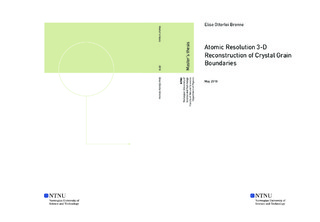| dc.description.abstract | Grain boundaries are typical crystal defects, which to a large extent determines the macroscopic properties of the material. In order to control these properties and design new materials, detailed knowledge about the atomic structure of such defects is essential. As atomic resolution has become routinely available in scanning transmission electron microscopy (STEM), tools for obtaining three-dimensional (3-D) information from the projection data are valuable.
In this thesis, a method for 3-D reconstruction of the atomic structure in crystal grain boundaries is developed. The method is based on tomographic reconstruction from images acquired by high-angle annular dark field (HAADF) STEM. Through application on a model grain boundary in yttrium-stabilized zirconia (YSZ), an important material in energy applications, the method was demonstrated to accurately determine the 3-D positions of all atoms in the structure from only three projection images. This revealed information about the grain boundary structure that has not previously been available, providing details that could not be identified in the projected images alone. A precision of \SI{4}{\pm} was reached, estimated from comparison with the well-known bulk structure of YSZ. Moreover, as the developed reconstruction method enables direct 3-D structure retrieval from experimental images, it provides an accurate atomic scale model which can serve as an ideal starting point for further theoretical investigations.
Methods for preparing the experimental images are also developed, including distortion correction, noise reduction and atom column localization, crucial for an accurate reconstruction. These, together with the tomographic reconstruction method, are implemented in Python. A tutorial is written to illustrate how to use the code, included in the appendices of this thesis, contributing to making tomography an easily accessible tool in GB research. | en |

